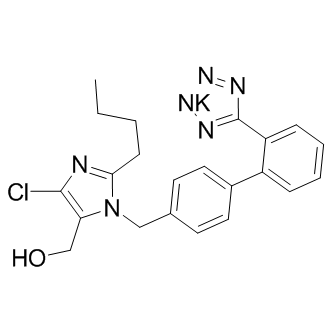| References: |
Losartan is an angiotensin II receptor antagonist, competes with the binding of angiotensin II to AT1 receptors with IC50 of 20 nM.in vitro: Pre-incubation with losartan (LOS), an antagonist of ATR1 prevented the effect of ANGII on ISC. Transcripts for ATR1 in Xenopus lungs and H441 cells were detected and an increase of ISC was observed by ANGII in native Xenopus lung epithelia. Pretreatment with the AGTR1 blocker losartan significantly reduced Ang IImediated cell proliferation. Suggest losartan could block Ang II mediated cell proliferation.
in vivo: Losartan (0.6 g/L in their drinking water) prevents elastic fiber fragmentation and blunted TGF-β signaling in the aortic media in pregnant Fbn1C1039G/+ mice, as evidenced by reduced nuclear accumulation of pSmad2. Losartan (0.6 g/L in their drinking water) shows a reduction in distal airspace caliber in pregnant Fbn1C1039G/+ mice. Losartan (0.6 g/L in their drinking water) improves disease manifestations in the lungs, an event that cannot plausibly relate to improved hemodynamics in pregnant Fbn1C1039G/+ mice. Losartan (10 mg/kg) administration increases blood angiotensin levels four fold to six fold, blood BK levels are unchanged in male Sprague Dawley rats. Losartan (10 mg/kg) increases plasma renin levels 100-fold, plasma angiotensinogen levels decreases to 24% of control and plasma aldosterone levels are unchanged in male Sprague Dawley rats. |























